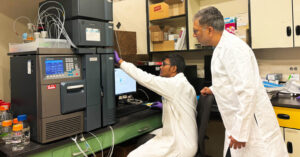
Known as “forever chemicals,” per- and polyfluoroalkyl substances (PFAS) are a group of synthetic materials that have been widely used in various industrial and consumer products, such as non-stick cookware, water-repellent clothing, and firefighting foams. Their resistance to degradation combined with their potential to accumulate in living organisms has raised significant concerns about their impact on human health and the environment. While significant progress has been made in understanding PFAS, we are still unraveling the dangers they pose, including their environmental impact.
As PFAS contamination through land applied biosolids and their plant uptake continues to escalate risks to both environmental and public health, Ramesh Goel‘s groundbreaking research will be tackling this critical issue head-on, supported by a nearly $1.6 million grant from the U.S. Environmental Protection Agency (EPA).
This project — one of ten grants awarded nationwide to address the PFAS crisis in agricultural, rural, and tribal communities — underscores the University of Utah’s dedication to tackling critical challenges that affect the region.
An Urgent Concern
PFAS chemicals in municipal wastewater has become a pressing environmental issue. Current treatment methods at wastewater treatment plants (WWTPs) are largely ineffective at removing or fully degrading PFAS, leading to their presence in biosolids. Biosolids, the nutrient-rich organic material generated from sewage treatment, are commonly used as fertilizers in agriculture. It is estimated that between 2,749 to 3,450 kilograms of total PFAS are present in the biosolids produced in the U.S., with half of these chemicals entering agricultural soils. In 2019, approximately 4.5 million dry tons of biosolids were generated by municipal WWTPs in the U.S., and around 2.44 million dry metric tons were applied to land.
This recent set of EPA grants is focused on developing a better understanding of “bioaccumulation,” or how pollutants like PFAS can become more concentrated in plants and animals that grow or graze on polluted ground.
Continue reading Fighting Forever Chemicals at the Department of Civil & Environmental Engineering.